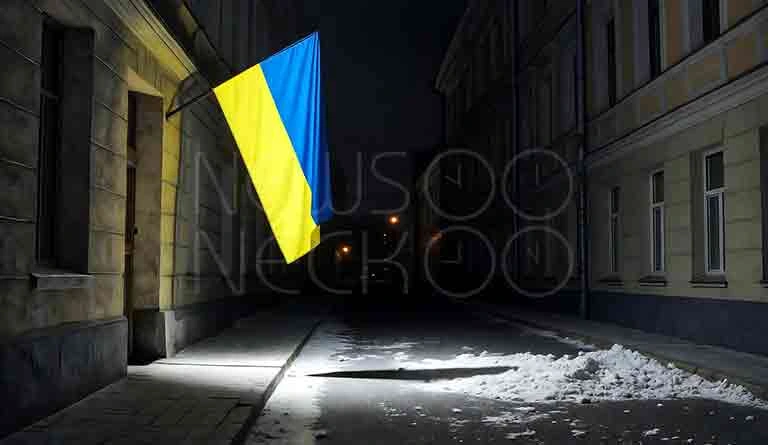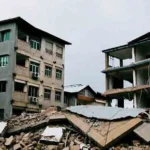Darkness Before Winter: Russian Strikes Leave Kyiv in the Dark
A massive barrage of drones and missiles targets Ukraine’s energy infrastructure, killing a child and plunging the capital into darkness as winter approaches.
KYIV, Ukraine — The explosions came in the night, a terrifying symphony of air raid sirens and blasts that shook buildings and shattered sleep. By morning, parts of Kyiv had fallen silent and dark the power cut, the water taps dry, the subway still. The only light came from the flames engulfing a 17-story apartment building in the heart of the capital.
In the early hours of Friday, October 10, 2025, Russia launched one of its largest attacks of the war on Ukraine’s energy infrastructure, firing more than 450 drones and over 30 missiles across the country. The assault killed at least one person, a 7-year-old boy in the southeastern city of Zaporizhzhia, and injured at least 20 people in Kyiv alone, with casualties reported in multiple regions.
For Ukrainians, the attack marked a grim return to a familiar Russian strategy: targeting heat and power as winter approaches. The timing was no accident, coming just as the bitter cold of late October begins to grip the region.
A City Struggles to Light
Before dawn, the reality of the attack became clear. In Kyiv, the east bank of the Dnipro River lost power completely. The city’s subway system stopped running, leaving thousands stranded during their morning commute. Buses became so overcrowded they could not take more passengers.
“We had no power or water when I left my house,” said Anatoliy, a 23-year-old student who spent the night in his hallway during the explosions. “I can’t get to work because subway is not operating and buses are overflowing. I’m hoping for the best but I don’t even know how to reach the other bank”.
The damage extended far beyond the capital. Prime Minister Yulia Svyrydenko described the assault as “one of the largest concentrated strikes” against Ukraine’s energy infrastructure since the war began in February 2022. Power outages were reported in nine different regions, affecting thousands of families and businesses.
The human cost continued to emerge throughout the day. In the Zaporizhzhia region, a seven-year-old boy died from injuries sustained in the attack. His parents were also wounded. A relative also reported that the father had just “returned from russian captivity in March after being held for three years”.
The Winter Strategy Returns
The attack follows a pattern established in previous years of the conflict. Each fall since the full-scale invasion began, Russia has systematically targeted Ukraine’s energy infrastructure, aiming to collapse the power grid before winter sets in.
Ukrainian President Volodymyr Zelensky said that the strike is “a cynical and calculated attack” targeting “everything that sustains normal life, everything the Russians want to deprive us of”.
He also added that “It is precisely the civilian and energy infrastructure that is the main target of Russia’s strikes ahead of the heating season,”.
The consequences extend beyond immediate discomfort. Ukraine’s energy minister, Svitlana Grynchuk, described the assault as a “massive blow” to energy infrastructure. DTEK Group, Ukraine’s largest private energy producer, reported that its power stations had been severely damaged, with one energy worker injured. This marked the third strike on DTEK’s facilities in a single week.
A Table of Damage and Disruption
The widespread impact of the attacks across Ukraine is detailed below:
| Affected Area | Impact Details | Casualties |
|---|---|---|
| Kyiv | Power outages on left bank, water supply disruptions, subway system halted | At least 20 injured |
| Kyiv Region | 28,000 families without power | Not specified |
| Zaporizhzhia | 7-year-old boy killed, parents injured | Child killed, parents injured |
| Poltava Region | 16,500 households and 800 businesses lost power | Not specified |
The Human Stories in the Darkness
Amid the infrastructure damage and statistics are ordinary people adapting to yet another crisis.
Mykyta Varenya, a 26-year-old coffee shop owner from Kyiv, immediately turned to his generator when the power went out. “The lights were out, there was no water,” he said. “Last year, it had a big impact on my business. We had problems with the power generator at first, petroleum items are expensive, and roughly speaking, you end up breaking even, or even losing money with these outages”.
For older residents like 68-year-old Olena, who only gave her first name, the routine has become familiar. “There was no water or electricity in the morning,” she said while queuing at a local shop to buy water. “Today’s outage was unexpected. But I went and got some. I had a little, so I got a little more. We’ll survive somehow”.
Also Read: Shutdown Stalemate Grips America
A Call for Help and a Long Recovery
As restoration efforts began, Zelenskyy issued a sharp rebuke to Ukraine’s international partners, urging more than sympathy. “Together, we can protect people from this terror,” he said. “What’s needed is not window dressing but decisive action – from the United States, Europe, and the G7 in delivering air defense systems and enforcing sanctions”.
By Friday afternoon, energy workers had restored power to 270,000 consumers in Kyiv, though officials did not say how many had been affected in total. The water supply was expected to be fully restored in Kyiv and Kirovohrad region by the end of the day.
But the repairs come against a backdrop of escalating violence. The UN Human Rights Monitoring Mission in Ukraine reported that September had been another devastating month, with at least 214 civilians killed and almost 1,000 injured across Ukraine. The number of civilian casualties in the first nine months of 2025 increased by 31% compared to the same period in 2024.
As night fell again on Friday, the people of Kyiv faced the darkness with characteristic resilience. But with winter approaching and Russian attacks on energy infrastructure intensifying, the coming months threaten to test that resilience as never before.
This story was reported from Kyiv with contributions from journalists across Ukraine.
Author: Junaid Arif
Date: 10 Oct, 2025
For More Updates, Visit Newsneck













